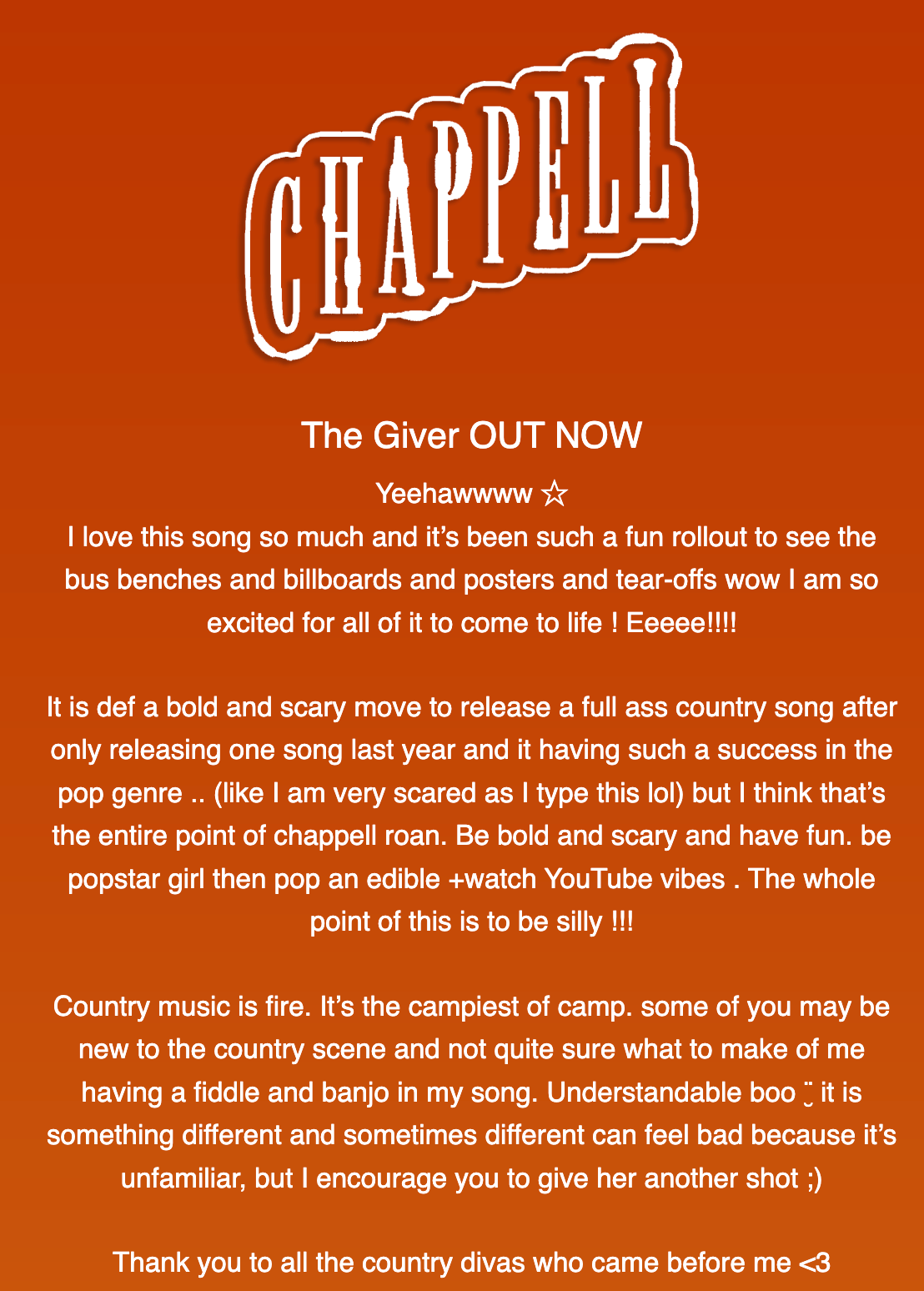A few months ago, I happened to open two musicians’ emails in close succession. The first was Chappell Roan. Sent around the time of her very iykyk launch for The Giver:
Feel like you’re in the girls’ chat, right? Now compare it to this from Maggie Rogers:
The sand-in-honey prose of the deep-feeling Harvard grad beside the rhinestoned queen of camp pop. Scrub their names and tell-tale song titles, and – still – you know it’s them.
In the months since I read those two pieces, I’ve been more consciously clocking musicians whose writing reads like their songs. They pop (or rock) up all over our Substack feeds, shelves and social.
Laura Marling’s introspective newsletter uses tarot “to provoke deeper contemplation on what hidden desires are driving us”. Nick Cave, the baritone bard of the tormented, pens letters like sermons. And then there’s Lola Young’s messy TikTok captions: ‘pls ignore the half removed lipstick ily all enjoy the new song.. just a tiny bit of whats been on my mind tn x’ ‘can u tell i like my sticky suction phone case ?’
Leonard Cohen’s novels brood like Hallelujah. Patti Smith’s Just Kids reads like black coffee and a boot heel crushing a cigarette in the rain – as fragile, feral and cool as Pissing in a River. Dylan’s experimental poetry book Tarantula is a fever dream of fragmented lines, just like the Subterranean Homesick Blues.
For the many of us here who write, it’s not surprising. An artist’s style transcends mediums. You can apply the same principle to their clothes, partnerships or what they choose to comment on publicly. But it’s pretty groovy to read their prose side by side. To hear their distinct sound, even when the band is silent. That’s tone of voice.
Write to be heard
An estimated 4 in 5 of us hear what we read. It’s called subvocalisation. Sometimes we do it in our own voice, sometimes in the voice of the friend who wrote our birthday card or characters chatting in our bedtime novel. We hear intonation. Emphasis. And if you write for brands? That’s how you cut through and connect with customers.
Many of us will know this famous lesson from Gary Provost’s 100 Ways to Improve Your Writing:
When we write, we’re not just picking adjectives; we’re setting a rhythm. We choose words like notes, construct sentences like melodies with grammar as the beat. Consciously or not, we set the cadence to stir people to action or calm, or pull their heartstrings.
Want your writing to sing? Beyond varied sentence length, there are loads of lyrical devices:
Switch up your structure. Use dashes, ellipses… those breathy run-ons (and the odd bracket too).
Dial up the energy with repetition. Think alliteration, half-rhymes and assonance (when syllables echo, like in ‘soft static’ ‘high tide’ or ‘deep sleep’).
Riff off the rules. Joan Didion said: “Grammar is a piano I play by ear.” So don’t sweat those complete sentences, it’s all jazz.
Let the mic drop. Find that line – clear, repeatable, unforgettable. Then let it breathe.
Read out loud. As Provost also said: “Listen for gaps... Hear how the use of the wrong word wakes you from your reading spell.”
But what genre are you?
If your brand had a soundtrack, what would it be?
HARD TRUTH: we’re not just in the business of creating “a sound that pleases the reader’s ear” (wouldn’t that be an easy brief?). We’re here to make it sound you. To find a voice that chimes with your brand’s bones. And getting inspired by – or getting specific with – music genres is a great way of going about it. Heavy-metal Liquid Death is an obvious example. But you might also think of Harley Davidson as full-throttle, heartland rock or Notion as some kind of ambient electronica.
Playlists have been a great tool in helping our clients find the groove of their brand identity. Mindful Chef’s was as feel-good as their meal kits with Walking on Sunshine and Wham! For KatKin, it was Pussy Riot, Rage Against the Machine and Smelly Cat – claws out with a twinkle in the eye. The genre set the tone.
And if you still need proof? Think back to the brand frenzy of Brat Summer 2024. That streetwise, electropop energy hit the right note for Asda’s content – cheap and unfussy. But Kate Spade’s posh-totty acid-green edit? It was totally off-key.
We’ve said it before and we’ll say it again: great writing starts with listening. To your customer, to culture… and now to Spotify. Ask: what tracks hits the spot? Bring that vibe into your tone. Whether you’re writing a manifesto or an Instagram caption, a hero statement or the 404 error message, write music. Find your tempo. And when in doubt? Press play.
The Prompt
Sound good? Let’s practice. Have a go at rewriting this line in different genres:
“It is a truth universally acknowledged, that a single man in possession of a good fortune, must be in want of a wife.”
Get choosy with your vocabulary but also really play with grammar, structure and rhythm.
Try an 80s power ballad (big builds, repetition, high volume), punk (abrupt, rule-breaking, raw) or go full Panic! at the Disco with high-drama asides. (Bonus points if you write in eyeliner.)
We’d love to see where you go with it.
The Vortex
Take a sexy picture of CMAT’s tone in her newsletter.
Do you know how to stargaze, people-watch and bargain like a pro? These teens do.
You are not your job, and soon you won’t have one.
And while you’re rethinking the future (again): watch these impossible AI influencer challengs on Google VEO 3.









